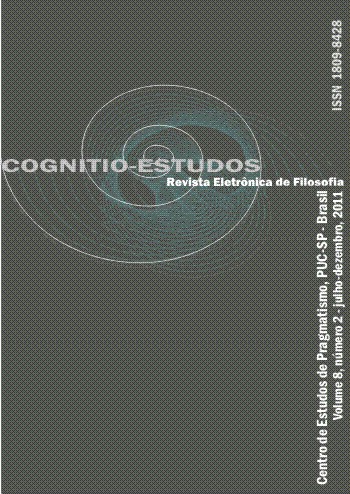Philosophical problem of relations according to Peirce – alliances towards an ontology of relations regarding two aspects of Synechism
Keywords:
Peirce, Relações, SinequismoAbstract
This paper aims to present Peirce’s philosophy as an alternative to the philosophy of being. Peirce’s ontology could not be ranked as a discourse about the reality of being (Aristotle); nor could it be understood as a scientific metaphysics ruled by transcendental conditions (Kant). Peirce evades from both traditions, as long as he builds his ontology from a semiotics-based reality whose mode of being is defined in terms of relations (monadic, dyadic and triadic relations). So I assume through my argument that Peirce’s ontology forges an essential alliance to the so-called ontology of relations (BAINS, 2006). I summarize the allies and principles of such ontology, and consequently I argue for Peirce’s part on it taking into account two elements of his Synechism: the primacy of relations over individuals in continuous multiplicities and the mode of being of relations according to triadic relations in the category of Thirdness.Metrics
References
ARISTOTLE. Metaphysics. Transl. D.W. Ross. London: Penguin Books, 2004.
BAINS, Paul. (2006) The primacy of semiosis: an ontology of relations. Toronto: University of Toronto Press, 2006.
CARDOSO JR., H. R. Peirce’s logic of relatives and the pluralism of continuity – relative and continuous predicates; paper accepted to the Third Congress on Universal Logic, Estoril, Portugal, 2010.
CARDOSO JR., H. R. Peirce’s mathematical-logical approach to discrete collections and the premonition of continuity, Journal of Applied Non-Classical Logic, vol. 22, No. 1/2012 (Uses of non-classical logic: foundational issues), pp. 19–41, 2012.
ERHLICH, P. The absolute arithmetic continuum and its Peircean counterpart. In: New essays on Peirce’s mathematical philosophy. M. E. Moore (Ed.); Open Court Press, 2010.
HAVENEL, J. Logique et Mathematique du Continu chez C.S. Peirce. These de doctorat à l’École de Hautes Études em Sciences Sociales (EHESS), Paris, 2006.
HOOKWAY, C. Peirce and mathematical structuralism. In: New essays on Peirce’s mathematical philosophy. M. E. Moore (Ed.); Open Court Press, 2006.
HUDRY J.-L. Peirce’s potential continuity and pure geometry. In: Transactions of the Charles S. Peirce Society, Vol. 40, No. 2, pp. 229–243, 2004.
JOHANSON, A. Modern topology and Peirce’s theory of the continuum. In: Transactions of the Charles S. Peirce Society, Vol. 37, No. 1, pp. 1–12, 2001.
KANT, I. Critique of Pure Reason. Cambridge: Cambridge University Press, 1998.
LEO, R. F. Il concetto di relazione in Peirce. Milano : Editoriale JACA Book, 1992.
MYRVOLD W. C. Peirce on Cantor’s paradox and the continuum. In: Transactions of the Charles S. Peirce Society, Vol. 31, No. 3, pp. 508–554, 1995.
MURPHEY, M. G. The Development of Peirce’s Philosophy. Indianapolis; Cambridge, MA: Hackett Publishing Company, Inc. 1ª ed.: Cambridge, MA: Cambridge University Press, 1993.
PEIRCE, C.S. (CP) Collected Papers of Charles Sanders Peirce. Ed. by Charles Hartshorne and Paul Weiss. Cambridge/Massachusetts, The Belknap of Harvard University Press, 1935.
PEIRCE, C. S. (NEM) The New Elements of Mathematics. Ed. by Carolyn Eisele. Haia; Paris: Mouton Publishers; Atlantic Highlands, NJ: Humanities Press, 4 v. in 5, 1976
PEIRCE, C.S. (W.) Writings of Charles Sanders Peirce: A Chronological Edition. Ed. by “The Peirce Edition Project”. Bloomington; Indianapolis: Indiana University Press, 1982-2000.
PUTNAM, H. Peirce’s continuum. In: Peirce and contemporary thought: philosophical inquires, K. Ketner (Ed.), pp. 1–22. New York, Fordham University Press, 1995.
ROSENTHAL, S.B. Charles Peirce’s Pragmatic Pluralism. New York: New York State University Press, 1994.
ZALAMEA, F. Peirce’s logic of continuity: Existential graphs and non - cantorian continuum. In: The Review of Modern Logic, Vol. 9, No. 1–2 [Issue 29], pp. 115–162, 2003.

